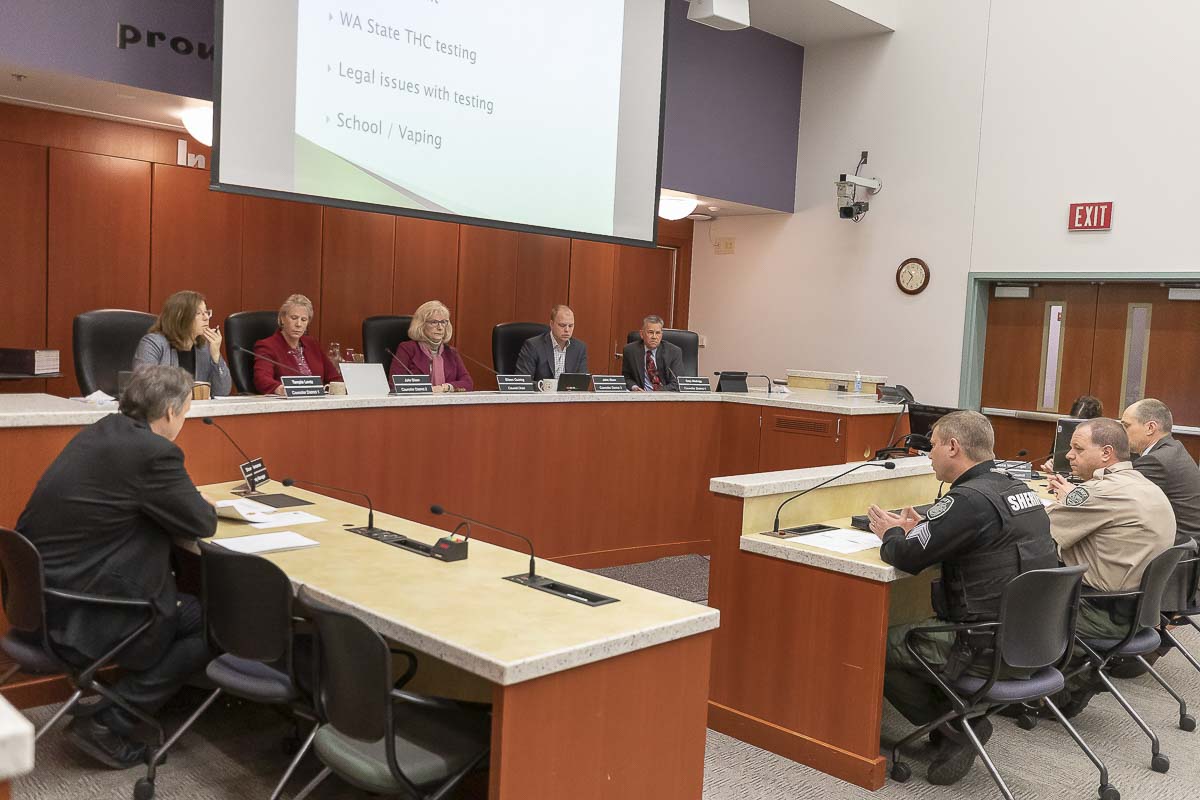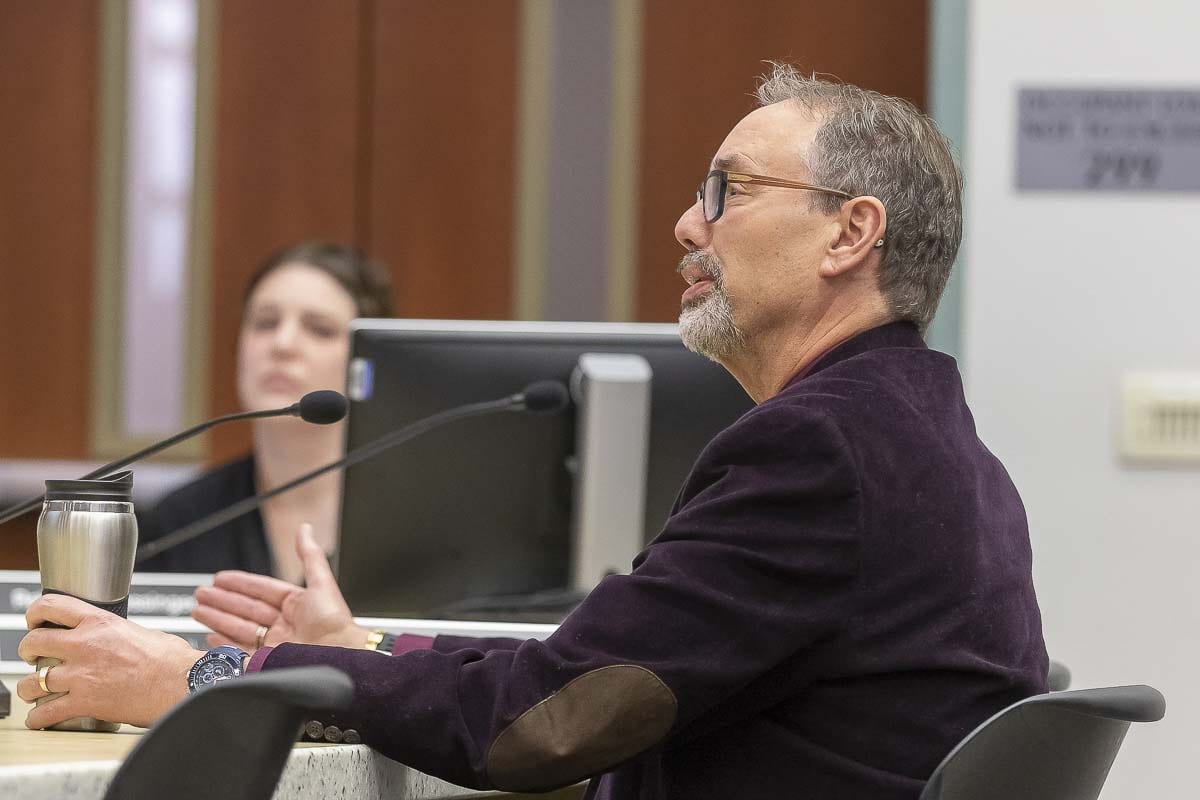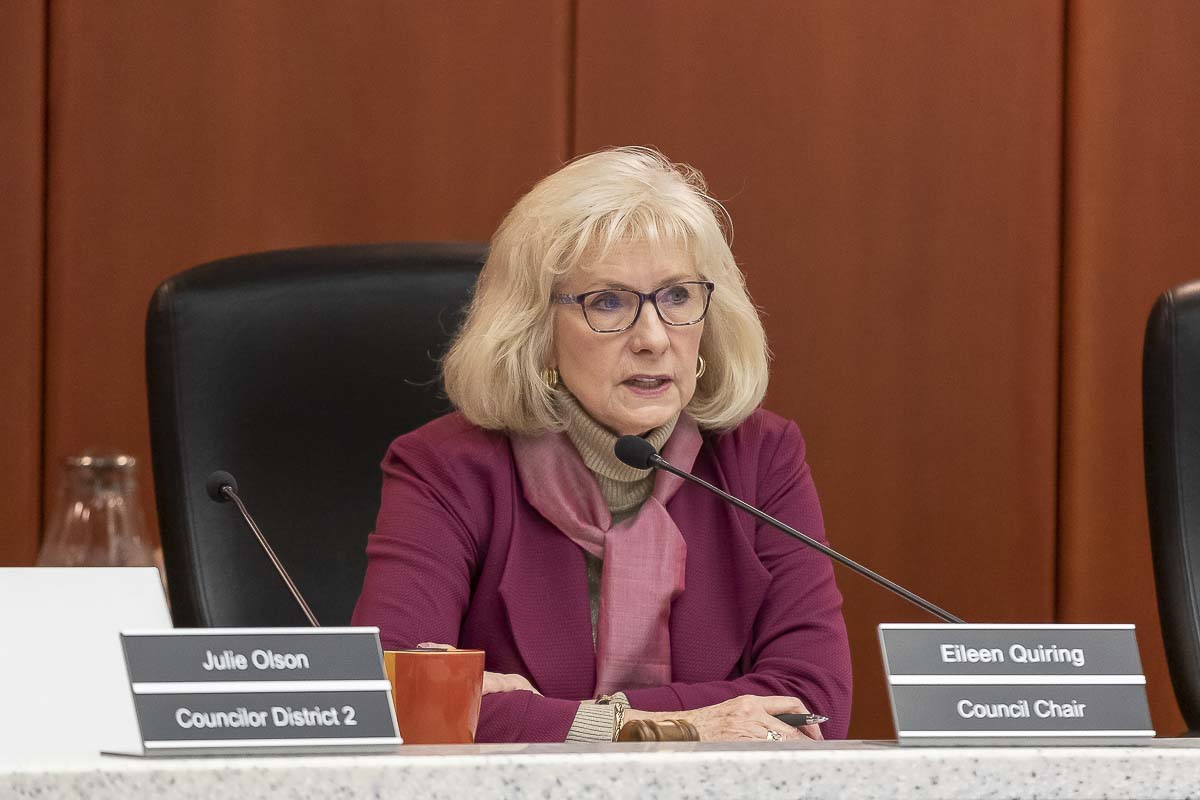The work session held Wednesday could be the first as the new council weighs the pros and cons of the 2012 ban
CLARK COUNTY — One of the most notable things about Wednesday’s County Council work session to talk about the 2012 moratorium on marijuana-related businesses in unincorporated Clark County may have been what wasn’t discussed.

There were almost no mentions of lost revenue, and no members of the marijuana industry asked to speak. Instead, the council heard from three members of the Clark County Sheriff’s Office, a Washington State Patrol trooper, the director of Community Services, and the county’s public health officer.
They ran through a long list of statistics and observations about what legalized marijuana sales have created in terms of criminal activity, impaired driving, and potential health concerns that remain largely unstudied.
Law enforcement supports the ban
In his role with the Clark County Sheriff’s Office traffic division, Sergeant Alex Schoening noted that he has been involved with nearly every fatal crash in the county since 2003. Out of 69 deadly crashes in that time, he noted, slightly over half involved some form of impairment, either alcohol, drugs, or both. Since recreational marijuana was approved by the voters in 2015, Schoening says, they’ve seen a sharp increase in drivers involved in deadly or serious injury crashes with marijuana in their system, usually in combination with alcohol and other drugs.
“Marijuana is affectionately known in law enforcement circles as the ‘ranch dressing’ of drugs because it’s good with everything,” says Schoening. “And that’s how we’re seeing it out on the roads. We’re seeing it not typically by itself.”
Schoening also noted that current methods require blood testing to confirm whether a driver involved in a crash was under the influence of marijuana. Given the time it takes to run those tests, the state toxicology lab now has a 7-9 month backlog of cases, leading to a logjam when it comes to potential criminal charges.
The designation of marijuana as a schedule one controlled substance at the Federal level, Schoening noted, also means that there are no analogous tests for how it impacts drivers compared to something like alcohol. Law enforcement use what are known as wet labs to test in a controlled environment for how certain levels of alcohol intoxication affect a driver’s cognitive ability. Currently, there are no “green labs” due to a lack of Federal funding for such research.
In his presentation, Clark County Commander Duncan Hoss, who works patrol for the sheriff’s office, spoke of the increased level of police activity around existing marijuana businesses. Main Street Marijuana in downtown Vancouver, for instance, saw 128 calls for service since 2016, nearly three times as many as the next closest surrounding business, which happens to be the Subway restaurant just across the street. Others weren’t as dramatic, but still generally saw much higher levels of police activity compared to surrounding businesses.
The only marijuana retail establishment in unincorporated Clark County, Sticky’s Pot Shop on Highway 99, which shut down last year after losing a court battle, had 19 calls for service since 2016. But, Hoss noted, 40 percent of calls for surrounding businesses still related to activity at Sticky’s. In several cases those were attempted break-ins, or homeless people petitioning others to buy them pot.
Several council members noted they would like to see how those calls for service related to other nearby businesses that deal in things like alcohol or tobacco products before deciding whether marijuana shops are completely unique in the number of calls to 9-1-1.
Commander John Horch, head of the county’s drug task force and major crimes unit, noted that marijuana sold today, especially in some edibles, can have THC levels of up to 90 percent. THC is the psychoactive element in marijuana that leads to the psychoactive effect most common to the drug. Horch said marijuana in the 60’s and 70’s likely had THC levels closer to between 2 and 7 percent, while the breeding and production process has been able to increase that to 30 percent or greater in modern strains.
“From day one Sheriff (Chuck) Atkins has been opposed to having marijuana retail sales in the county,” Horch told the council. “Obviously it was legalized four or five years ago, recreational use in Washington, and his position is that if people want to purchase it they can go to the city. He doesn’t feel that the benefit — any tax revenue that would come from it — offsets the problems we would have or the impact to the community.”

The council also heard from Trooper Ben Taylor with Washington State Patrol, who said marijuana now plays a role in the majority of traffic stops conducted by the agency. WSP is now in the midst of implementing the Advanced Roadside Impaired Driving Enforcement (ARIDE) Course, which, Taylor explained, aims to better educate law enforcement in recognizing signs of drug impairment, especially in combination with other drugs or alcohol use.
A 2016 national survey on drug use and health showed more than half of Americans consider themselves to be drinkers, and nearly 29 million people admitted to using illicit drugs in the past month. Of those, 84 percent said marijuana was either their drug of choice or something they use in addition to other illegal drugs.
A nationwide traffic enforcement operation between 2013 and 2014 tested nearly 30,000 drivers in 60 locations. Nearly 13 percent were found to have evidence of marijuana in their systems, and over 15 percent had at least one illegal drug present in their bloodstream.
“This is self-reported. This is somebody that you talk to that is going to tell you they’re using it,” said Taylor. “What I can say on the roadside part of things is marijuana is prevalent in about every vehicle that we contact anymore. I mean it’s pretty rampant.”
Taylor added that the smell of marijuana during a traffic stop used to be an automatic trigger to begin an arrest. Now it leads to a more complex investigation, including determining when the last time was that the drug was used, and whether there are any minors in the vehicle or in possession of the drug.
Teen marijuana use largely steady
The bulk of the work session was taken up by Clark County Public Health Officer Doctor Alan Melnick, who detailed a long list of studies into marijuana use among teenagers, studies into its potential health effects, and a rise in pot-related visits to local emergency rooms or calls to poison control for potential overdoses.
In a 68-page presentation, Melnick showed various surveys that showed marijuana use among 10th-grade students in Washington State actually declined slightly following the legalization of the drug, but remains alarmingly high, with over 29-percent of students in the state admitting to having tried the drug. Eighteen percent said they had tried marijuana in the past 30 days, a slight increase from 2016.

Perhaps the most alarming statistic, Melnick said, is the rising number of teenagers who believe that marijuana presents little or no health risk. The Healthy Youth Survey conducted last year showed 35 percent of Washington 10th-graders believe marijuana is largely safe to use, up from 16 percent in 2004.
More than 10 percent of minors who admit to using marijuana say they got it from a friend, while 3 percent say they had an adult friend buy it for them from a store. The legalization of marijuana does seem to have slightly reduced the black market, leading to more teenagers saying the drug is now marginally more difficult to obtain. That, despite the fact that the number of teenagers who say they live with someone who actively uses marijuana has increased slightly to more than 23 percent last year.
Melnick said nearly a third of 10th graders surveyed said their parents had never discussed marijuana with them, or warned them of the potential hazards of using it — a fact he found particularly disturbing. In Clark County last year, 8 percent of 10th graders admitted to driving a vehicle within three hours of using pot, while nearly 18 percent say they had ridden in a car in the past 30 days with someone who had recently smoked marijuana. That number has remained relatively unchanged since marijuana was legalized in Washington state.
In his report, Melnick said there is some evidence that heavy use of marijuana has been shown to potentially lead to greater incidences of schizophrenia or other mental issues. However, he admitted, it’s difficult to know whether marijuana use alone is the primary factor, or whether the use of the drug is a sign of other underlying issues that could lead to the psychological problems. Marijuana use, he noted, does not seem to be connected to an increase in symptoms of people who already have been diagnosed with schizophrenia, and may actually have some promise for helping to treat some of those symptoms.
More discussion to come
It has been 10 months since the previous county council last discussed potentially lifting the moratorium on marijuana business in the county.
At that work session, there was more discussion about how much money the county is potentially leaving on the table with its ban.
Retail locations are currently allowed only within the city limits of Vancouver and Battle Ground. As of January, Vancouver had 13 active marijuana retail locations, with one in Battle Ground. According to 502data.com, which tracks marijuana sales and tax revenue, those 14 locations brought in nearly $60 million dollars in 2017. Since 2014, sales have totaled nearly $400 million in Clark County, generating close to $100 million in sales and excise tax revenue.
Statewide, as of the end of 2017, the state had collected $319 million in tax revenue from the sale of marijuana. Most of that goes to fund healthcare services, with nearly $100 million going to the state’s general fund. A total of $6 million was sent back to cities and counties.
Wednesday’s work session provided no statistics for what the county stands to gain financially from the sale of marijuana, but research from the county’s Finance Office last year noted tax revenue could have amounted to as much as $625,000 in 2018, and up to $750,000 by 2020.
Unlike that meeting last May, no members of the local marijuana industry were invited to speak at the work session. Current Council Chair Eileen Quiring made it clear she is vehemently opposed to lifting the ban.
“It isn’t legal for teens to use marijuana, but because it’s legal for adults it affects teens,” said Quiring. “And I actually think that that’s the largest danger that we enter into with legalizing this.”
Quiring’s view is that opening up more locations for Clark County residents to buy or manufacture marijuana will increase access to vulnerable populations, such as teens and tweens, while current research shows that use of the drug could be especially harmful to still-developing minds.

“There’s no question about the concern for youth use of marijuana, and alcohol, and cigarettes, and vaping products,” responded Councilor Julie Olson, “that’s not, in my view, what we’re talking about here. We’re talking about whether Clark County lifts the ban on recreational marijuana in the county. It’s already legal in the state, it’s legal in 10 states.”
Several councilors said they would like to set up another work session in the future to hear more information about what the potential impacts of lifting the ban could be, including how it could affect existing county code and zoning.
District 1 Councilor Temple Lentz has already gone on record as saying she would support lifting the moratorium. Other councilors, outside of Quiring, have so far played things closer to the vest, though it’s clear that there may be more momentum now for upending the ban than at any point since it was put in place.
Industry supporters speak out
While they weren’t invited to speak at Wednesday’s work session, several members of the local marijuana industry attended the meeting.
Terah Pitchford, a Clark County resident who works for Landrace Labs, a marijuana producer and processor, said outside of the tax revenue argument is a discussion around access for people who use the drug for medicinal reasons with a prescription from their doctor.
“A lot of people don’t understand that when the recreational cannabis market was developed that our medical patients suffered from that,” says Pitchford, “because their access to the medicine that they’re using actually decreased, partially because of things like this moratorium.”
Pitchford says her industry is sympathetic with the issues surrounding youth and cannabis use, and that they work closely with the state’s Liquor and Cannabis Board on regulations to try and ensure teenagers have a more difficult time getting ahold of the drug.
Jim Mullen, co-owner of The Herbery, which has three retail locations inside Vancouver city limits, says it’s his view that having better access to legal recreational marijuana helps to reduce the black market trade for the drug.
“I know first hand that, in the city of Vancouver, we helped kind of close down some of the black market, you know, smaller operations because we have become price competitive and the selection that we have,” says Mullen. “We’ve had guys come in and say ‘I stopped growing because you guys beat my prices now, and you have better selection.'”
Mullen, who did speak at the work session last year, said he would hope the county reaches out to the city of Vancouver for their next round of talks over the moratorium, and maybe get input from the Liquor and Cannabis Board about enforcement and regulation efforts.
“The revenue is not necessarily the main driver,” says Mullen. “The main factor is it is legal, it’s spreading across the country, more states are legalizing it for medical or recreational. Congress is looking at a safe banking act now to provide banking for us because we are still a cash business.”
The council did not set a date for any follow-up discussion on potentially lifting the moratorium, but the majority said they would like to continue the conversation in the near future.




